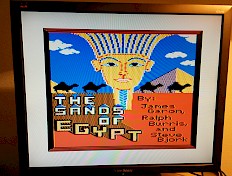About CoCoVGA
CoCoVGA is a hardware upgrade that produces VGA output from the TRS-80 Color Computers 1 and 2 and Dragon systems.
The current version monitors the digitial signals of the Motorola 6847 Video Display Generator (VDG) chip and imitates its functionality, producing a 640x480 60Hz VGA video output. CoCoVGA supports the standard text, semigraphics, and graphics modes (even those not supported by BASIC). It adds lowercase, multiple artifact modes, scanline emulation, a customizable palette, a 16-color 128x96 graphics mode, and a software-configurable character set, in addition to other features. It operates in both NTSC (60Hz refresh) and PAL (50Hz refresh) systems.
To do this requires that the installer remove the 6847 from the system's main board and place the CoCoVGA board in the 6847 socket. Then the 6847 must be placed in the CoCoVGA board.
Currently, boards exist which fit models of the CoCo 2 (including the 6847T1), the F board CoCo 1, and several types of Dragons. We are considering alternate board form factors to support more TRS-80 Color Computer systems, as well as the MC-10.
Project Contributors
Hardware
- Early inspiration (video chip replacement on TI-99/4a: the F18A project - here and here to produce VGA output) and guidance on FPGA to TTL level shifting: Matthew Hagarty
- 6847 reverse-engineering: Brendan Donahe and Steve Spiller
- Initial hardware prototyping: Brendan Donahe and Steve Spiller
- FPGA design: Brendan Donahe
- Prototype board design: Ed Snider
- Production board designs: Ed Snider
- Board and cable assembly: Ed Snider
- SAM accelerator design and assembly: Ed Snider
Software
- Blanking region combo-lock concept and 6809 assembly language routine: Brendan Donahe and Steve Spiller
- Demos, tests, and utilities: Brendan Donahe and Steve Spiller
- Infocom game ports to use 64-column mode: Ed Snider
- CCVEDIT (the CoCoVGA custom character set editor): Brendan Donahe
Web Site
- CoCoVGA logos and color scheme: Robin Donahe
- Content management software: ProcessWire atop Apache, MySQL, and PHP
- Color Computer true-type fonts: Rebecca G. Bettencourt
Special Thanks...
- to Ed Snider for:
- application of rock-star hardware skills to board design and production
- application and game software to take advantage of enhanced modes including VG6 (16-color 128x96) and W64 (64-column text mode)
- general guidance, tips, and intelligent questions
- to Pere Serrat for:
- swiftly and adeptly porting CoCoVGA demo, game, and utility software to Dragon systems
- developing the CoCoVGA palette configuration and game launching menu and kindly accepting and incorporating feedback
- reporting several design bugs
- to Ron Klein for:
- his rigorous testing of numerous software releases, including but not limited to 64-column text mode CCVEDIT (the CoCoVGA character set editor) and for checking out various FPGA hardware updates, as well
- to Boisy Pitre, L. Curtis Boyle, and David Ladd for:
- application of their amazing NitrOS-9 knowledge and awesome programming skills to enable 64-column text mode in NitrOS-9 Level 1
- to David Linsley for:
- his donation of a PAL Dragon 32 to confirm and, in the future, ensure CoCoVGA compatibility
- to Simon Jonassen for:
- pointing out the ability of the 6847 to display 11 simultaneous colors on the text/SG4 display
- numerous challenging demos to run against CoCoVGA
- to Carlos Comacho for:
- providing very interesting character set sprites that are now available as CoCoVGA programmable character sets
- to Steve Strowbridge for:
- producing video interviews and reviews of CoCoVGA games
- providing useful feedback on CoCoVGA features and software
- to Marty Jenkins for:
- documenting his FPGA update issues related to the USB Blaster under Windows and the resolution thereof
